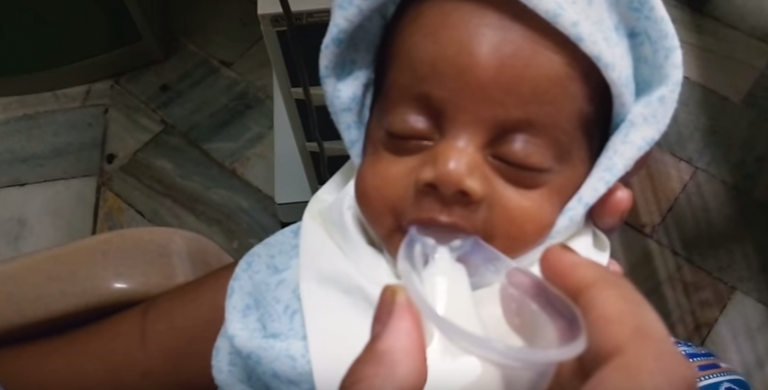A proven, cost-effective, and evidence-based solution already exists to prevent infant deaths. As we celebrate World Breastfeeding Week, it’s time to come together as a global health community to align our efforts and put the power of human milk to work.
Child health experts and health care workers know that early access to human milk can mean the difference between life and death for sick or vulnerable newborns. In a global context where 2.7 million babies still lose their lives in their first month, increased access has the potential to transform infant health and survival. Although support for breastfeeding is widely recognized as a high-impact intervention, as in the Every Newborn Action Plan, disconnects still slow effective implementation at scale.
Fortunately, we know what we need to do. At PATH, the global health organization where I work, we’re already collaborating with local and international policymakers and partners to strengthen the systems that ensure access and intake of human milk for all infants—and I’ve seen the staggering impact we can have. Here are four goals that we recommend to our global community in order to accelerate progress in saving newborn lives:
- Improve data. There is an absence of high-quality, national-level data about how babies are fed in neonatal intensive care units (NICUs) and the support that mothers receive for breastfeeding. Despite the routine early initiation of breastfeeding indicators, we still don’t have a clear picture of what proportion of sick newborns are receiving formula, human milk (from their mother, as pasteurized donor human milk from a human milk bank, or informally shared from another mother on the ward), or a combination of both. This hinders our ability to truly understand the need for better nutrition during this critical period and implement evidence-based interventions. It is time to prioritize work with national and local leaders to improve the quality of indicators, so that we are capturing accurate information on the feeding of vulnerable infants.
- Support mothers to breastfeed—by supporting NICUs. Despite improvements, adequate support for mothers in NICU settings for expressing and pumping milk, storing of milk, and supporting overall lactation is lacking. Even though preterm infants are often too young developmentally to feed at their mother’s breast, we need to encourage the mother to continue building up her milk supply through appropriate support. This in turn provides better nutrition for her own baby and sets her up for success in the long term to eventually breastfeed her baby. Together, we must prioritize the breastfeeding policies, guidelines, investment, and support that NICUs, moms, and babies need as part of an overall approach to protecting, promoting, and supporting breastfeeding.
- Strengthen human milk banking systems. It is estimated that up to 40 percent of neonates in NICU settings require donor human milk at some point during admission, either as a single feed or long term, due to a lack of mother’s own milk because of sickness, death, or simply delayed lactation. If mother’s milk is unavailable, the World Health Organization recommends use of donor human milk from a human milk bank as the best alternative, followed by formula. Human milk banks collect, pasteurize, test, and store safe, donated milk from lactating mothers and provide it to infants in need, ensuring that even if babies cannot breastfeed, they still receive human milk as soon as possible. In many countries, systems for provision of safe donor human milk are still in their infancy stages but enthusiasm and investment are growing. Let’s give more babies access to safe donor milk by supporting these systems with greater funding, focus, and an aligned global vision.
- Working together for our littlest citizens. Finally—and perhaps most importantly—it is time for us to pull together as a global community. Too often, health leaders partition the provision of human milk for sick and vulnerable infants as either a “nutrition” or “newborn” program responsibility. There is a better approach: making access to human milk a combined and shared priority. Let’s ensure that human milk is included in national and global policies and priorities, and that we protect, promote, and support it as an essential first food and as a core component of early and essential newborn care.
As a leader in maternal, newborn, and child health, PATH—in collaboration with partners worldwide—is already taking bold steps toward these goals. For example, we know that the approximately 600 existing human milk banks worldwide are inadequate to meet existing need. Although the provision of donor human milk is a global policy recommendation, detailed global guidance does not exist. Guidance on regulation, safety, and ethical use of human milk is needed from a global policy level to inform effective implementation of human milk banks. Therefore, we are working with policy and technical leaders in countries around the world to develop locally adapted guidelines and standard operating procedures for human milk banks, providing technical assistance to new and existing programs, and evaluating inexpensive technologies to help low-resourced banks safely process milk. In all our work, we are guided by a singular belief: that integrating human milk banking within nutrition and newborn care is the most effective approach to increasing access and intake for all infants.
Imagine how much more we can do together. As we celebrate the theme of this year’s World Breastfeeding Week, “Sustaining Breastfeeding Together,” we call on the global newborn community to recognize that cohesive and aligned strategies are critical for accelerating neonatal survival goals. A united front—of implementers, policymakers, funders, and communities—can strengthen the policies and implementation strategies we need to give every baby equitable access to lifesaving, evidence-based human milk.
WATCH:
- Learn more about PATH’s work to improve access to human milk, and what you can do to help.
- Explore our global perspective on human milk banking.
- See our work to expand human milk banking in India.
- Take a “virtual tour” of Vietnam’s first-ever human milk bank—established with PATH support.
https://www.3dvenue.xyz/3d-model/human-milk-bank-da-nang/
Blog by Kiersten Israel-Ballard, Associate Director – Maternal, Newborn and Child Health/Nutrition, PATH
